HINDU LIFESTYLE
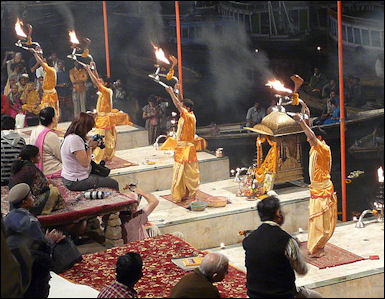
Evening Aarti (fire ceremony) at Dashashwamedh ghat VaranasiAccording to the “Encyclopedia of World Cultures”: Hinduism is more a "way of life," a cultural form, than it is a "faith," for its ethical and metaphysical principles pervade most acts of daily life: taking food, performing other bodily functions, walking around, conducting any business enterprise, farming, arranging marriages, bringing up children, preparing for the future, etc. These are just some of the things with which nearly everyone will be involved, yet all of them are tinged with religious rules. [Source:“Encyclopedia of World Cultures Volume 3: South Asia,” edited by Paul Hockings, 1992 |~|]
Hindu households typically have a prayer platform or room that is considered the most sacred place in the home. Devout Hindus are usually vegetarians and engage in daily prayer, fasting, and worship of their deity, particularly on holy days and during festivities. As part of their religious practices, Hindus take regular morning baths, recite and chant specific mantras, light incense, prepare particular food items, offer flowers to the deities, and worship their ancestors. [Source: International Encyclopedia of Marriage and Family, Gale Group Inc. ++]
A "good Hindu" is one who strives to do his or her duty toward a person's family and caste traditions (dharma) and who shows devotion to certain gods. Regular temple attendance is not mandatory, nor is worship of a specific deity or study of a particular scripture. There are no rules about obligatory prayer at certain hours or on certain days. It is true that one could follow any religious practice and still be considered a Hindu if they are Indian. It is not surprising that many Hindus view the Buddha and even Jesus Christ as incarnations (avatars) of Vishnu, one of the three main deities of Hinduism (the others being Shiva and Brahma). In the past, Hinduism likely assimilated local tribal deities into its extensive pantheon by designating them as avatars or as relatives (such as a wife, son, or daughter) of already established deities. |~|
According to Hindu ideology, a person's life consists of four stages, which correspond to the stages of the human life cycle. The first stage is the Brahamacharya Ashram
(apprenticeship), a period of discipline and education. The second stage is the Grihastha Ashram (home and family), which is devoted to marriage, parenthood, family, and establishing a household. The third stage is the Vanaprastha Ashram (gradual retreat), characterized by gradual retreat and weakening of emotional, social, and material ties. Finally, the goal of the fourth and final stage, the sanyasa ashram (renunciation), is to seek solitude, indulge in meditation, prepare for death, and strive for salvation and wisdom. ++
Hindu Rites
Hindu religious rites are classified into three categories: 1) Nitya rituals, which are performed daily and consist in offerings made at the home shrine or performing puja to the family deities; 2) Naimittika rituals, which are important but only occur at certain times during the year, such as celebrations of the festivals, thanksgiving and so on; and 3) Kamya, rituals such as pilgrimages which are "optional" but highly desirable. [Source: BBC]
Most Hindus perform religious rituals at home. These rituals vary greatly among regions, villages, and individuals. While not mandatory in Hinduism, they are a personal choice. Devout Hindus perform daily rituals such as worshiping at dawn after bathing. This usually takes place at a family shrine and typically includes lighting a lamp and offering foodstuffs before the images of deities. They also recite religious scripts, sing bhajans (devotional hymns), practice yoga and meditation, and chant mantras.
The Hindu ceremony of puja is a fundamental Hindu rite. It involves honoring a deity with a consecrated image. The practice of puja varies considerably throughout the country. Hindus choose their deities individually, and domestic shrines incorporate images reflecting the choices of household members. Many Hindus perform puja in their homes. Daily rites such as bathing, dressing, decoration with flowers and vermilion, and offerings of flowers and food attend a god. The ritual involves darshana, where the devotee sees the deity and is seen by the deity. Additionally, the devotee receives prasada, which is food symbolic of the deity's grace. Puja is also performed in temples, with priests officiating.
Websites and Resources on Hinduism: Hinduism Today hinduismtoday.com ; India Divine indiadivine.org ; Wikipedia article Wikipedia ; Oxford center of Hindu Studies ochs.org.uk ; Hindu Website hinduwebsite.com/hinduindex ; Hindu Gallery hindugallery.com ; Encyclopædia Britannica Online article britannica.com ; International Encyclopedia of Philosophy iep.utm.edu/hindu ; Vedic Hinduism SW Jamison and M Witzel, Harvard University people.fas.harvard.edu ; The Hindu Religion, Swami Vivekananda (1894), .wikisource.org ; Advaita Vedanta Hinduism by Sangeetha Menon, International Encyclopedia of Philosophy (one of the non-Theistic school of Hindu philosophy) iep.utm.edu/adv-veda ; Journal of Hindu Studies, Oxford University Press academic.oup.com/jhs
RECOMMENDED BOOKS:
“Hindu Rites And Rituals: Origins And Meanings” by K V Singh Amazon.com ;
“Hindu Rites, Rituals, Customs & Traditions” by Prem P. Bhalla Amazon.com ;
“Durga Puja,Lakshmi Puja,Saraswati Puja,Navratri Puja : Hindu Home Puja Book: Complete Ritual Worship Procedure” by Santhi Sivakumar Amazon.com ;
“Shiva Beginner Puja” by Swami Satyananda Saraswati and Shree Maa Amazon.com ;
"An Introduction to Hinduism" by Gavin Flood Amazon.com ;
“Hinduism for Beginners - The Ultimate Guide to Hindu Gods, Hindu Beliefs, Hindu Rituals and Hindu Religion” by Cassie Coleman Amazon.com ;
“Hindu Myths: A Sourcebook” translated from the Sanskrit by Wendy Doniger (Penguin Classics, 2004) Amazon.com ;
“The Rig Veda” by Anonymous and Wendy Doniger (Penguin Classics) Amazon.com ;
"The Hindus: An Alternative History" by Wendy Doniger; Amazon.com ;
“The Upanishads” by Anonymous and Juan Mascaro (Penguin Classics) Amazon.com ;
“Myths and Symbols in Indian Art and Civilization” by Heinrich Zimmer (Princeton University Press, 1992) Amazon.com
Bathing in the Ganges

Ganges Bath Hindus bath in, drink and throw the cremated ashes of the dead in the Ganges. Sprinkling holy water from the Ganges over one's head is believed to wash away sins, purify unclean souls and heal the sick. Bathing in the Ganges even once is supposed to ensure salvation. If a person dies in the Ganges or a has a few drops of Ganges placed on his tongue as he breaths his last breath it is believed he will achieve absolute salvation, escape the toil of reincarnation and be transported to Shiva's Himalayan version of heaven.
Every morning Hindus gather on the shores of the Ganges to bathe and pray for liberation from the world. The pouring of marigolds into the Ganges is a traditional peace offering. The river carries the petals to the oceans and the far corners of the world, carrying the promise of peace with them. Many people collect water from the Ganges in bottles. Some devoted Hindu take Ganges water to drink when they travel abroad.
According to the maharajah of Varanasi. "It is only after my ritual bath and while I am eating that I cannot touch anyone other than members of my household who have performed the same purification rituals. To do so would make me ritually impure. But goodness does not come only by touching and eating with people; it comes from much more.” [Source: John Putman, National Geographic October 1971]
Vedic Chanting
Tradition The of Vedic chanting was inscribed in 2008 on the UNESCO Representative List of the Intangible Cultural Heritage of Humanity. According to UNESCO: “The Vedas comprise a vast corpus of Sanskrit poetry, philosophical dialogue, myth, and ritual incantations developed and composed by Aryans over 3,500 years ago. Regarded by Hindus as the primary source of knowledge and the sacred foundation of their religion, the Vedas embody one of the world’s oldest surviving cultural traditions. [Source: UNESCO Intangible Cultural Heritage |+|]

student at a Vedic school learning the Veda
“The Vedic heritage embraces a multitude of texts and interpretations collected in four Vedas, commonly referred to as “books of knowledge” even though they have been transmitted orally. The Rig Veda is an anthology of sacred hymns; the Sama Veda features musical arrangements of hymns from the Rig Veda and other sources; the Yajur Veda abounds in prayers and sacrificial formulae used by priests; and the Atharna Veda includes incantations and spells. The Vedas also offer insight into the history of Hinduism and the early development of several artistic, scientific and philosophical concepts, such as the concept of zero. |+|
“Expressed in the Vedic language, which is derived from classical Sanskrit, the verses of the Vedas were traditionally chanted during sacred rituals and recited daily in Vedic communities. The value of this tradition lies not only in the rich content of its oral literature but also in the ingenious techniques employed by the Brahmin priests in preserving the texts intact over thousands of years. To ensure that the sound of each word remains unaltered, practitioners are taught from childhood complex recitation techniques that are based on tonal accents, a unique manner of pronouncing each letter and specific speech combinations. |+|
“Although the Vedas continue to play an important role in contemporary Indian life, only thirteen of the over one thousand Vedic recitation branches have survived. Moreover, four noted schools – in Maharashtra (central India), Kerala and Karnataka (southern India) and Orissa (eastern India) – are considered under imminent threat.” |+|
Hindu Mantras and Yantras
Mantras are chants usually based on sacred scriptures taken from the Vedas. They are necessary for "puja" and are seen as a ways of linking heaven and earth and summoning a deity. The most common mantra is "Om," the sacred sound of the Vedas. It is said to be the first sound heard during creation.

Kali yantra
Mantras are usually chanted in Sanskrit and sometimes accompanied by pounding drums and clanging brass bells and cymbals. Some mantras consist of simply repeating a deity’s name over and over. Hindus believe that chanting the names of deities will speed up their path to salvation and help them achieve “moshka” and escape from reincarnation.
The words of the mantras are "themselves sacred," and "do not constitute linguistic utterances." Instead, as Klaus Klostermaier has noted in their application in Vedic rituals they become magical sounds, "means to an end." From the Brahmanical perspective, the sounds have their own meaning, with mantras considered "primordial rhythms of creation", preceding the forms to which they refer. By reciting them the cosmos is regenerated, "by enlivening and nourishing the forms of creation at their base. As long as the purity of the sounds is preserved, the recitation of the mantras will be efficacious, irrespective of whether their discursive meaning is understood by human beings." [Source: Wikipedia]
“Mandalas” are diagrams of the universe that is viewed as a concentric set of squares with the Supreme Being at the center. “Yantras” are diagrams of the universe based on mandalas and related to various deities and uses. Simple ones consist of a circle within a square, within a rectangle, with four gates to represent the four directions of the universe. More complex ones are made of upward and downward pointing triangles centered around the central point of the deity. Yantras are models of force and sound and serve meditation aides.
Hinduism, Ahisma and Respect for Animals
Hinduism is a term that embraces many different although related religious ideas. Therefore, there is no clear single Hindu view on the right way to treat animals. However, in general, the doctrine of ahimsa leads Hindus to treat animals well. The cow is greatly revered by Hindus and is regarded as sacred. Killing cows is banned in India and no Hindu would eat any beef product. In addition: 1) Butchery and related jobs are restricted to people of low caste; 2) Most Hindus believe that non-human animals are inferior to human beings; 3) Some Hindu temples keep sacred animals; 4) Some Hindu gods have animal characteristics. Ganesh has the head of an elephant. Hanuman takes the form of a monkey
The Hindu view towards living things is guided by Ahisma, a concept that originated in Jainism but is also widely accepted in Hinduism and Buddhism. According to the BBC: Jains believe that the only way to save one's own soul is to protect every other soul, and so the most central Jain teaching, and the heart of Jain ethics, is that of ahimsa (non-violence).” [Source: BBC |::|]
Hindus advocate ahimsa because divinity is believed to permeate all beings, including plants and non-human animals. The term ahimsa appears in the Upanishads, the epic Mahabharata and ahimsa is the first of the five Yamas (vows of self-restraint) in Patanjali's Yoga Sutras. The Jain founder “Mahavira taught that: ‘there is no quality of soul more subtle than non-violence and no virtue of spirit greater than reverence for life.’ In practical terms the biggest part that ahimsa plays in the lives of lay Jains today is in the regulation of their diet.
While some Hindus believe that all animals are sentient beings and thus do not eat meat, many others eat meat just as many Jews eat non-kosher foods and Muslims occasionally drink alcohol. Hindu spiritual leaders (priests, swamis and gurus) and holy men (sadhus) are more likely to be vegetarian than lay Hindus. Some Hindus, such as those belonging to the Shaktism tradition, and Hindus in regions such as Bali and Nepal, practice animal sacrifice. They eat the sacrificed animal as ritual food. However, Vaishnava Hindus abhor and vigorously oppose animal sacrifice. Hinduism has thoroughly adopted the principle of non-violence to animals, making animal sacrifice uncommon and historically reduced to a vestigial marginal practice. [Source: Wikipedia, Listverse]
Vegetarianism and Hindus
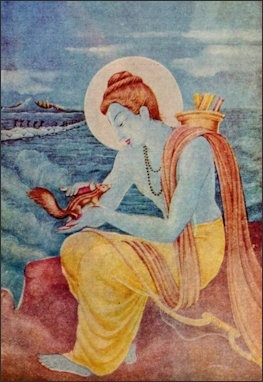
Rama with a squirrel
Many Hindus practice vegetarianism, but not all of them. By one estimate only 30 to 35 percent of Hindus are vegetarians. Even though they make up a minority of Hindus, they make up the vast majority of vegetarians worldwide, who total over 300 million people.
Hindus that practice vegetarianism do so because of the spiritual belief of ahimsa — the principle of nonviolence against all living things. Ahimsa prescribes negative karma on a variety of levels for the slaughter and consumption of meat products, On top of this, Hindus regard cows as sacred and most Hindus do not eat beef just as most Muslim don’t eat pork.
Shashank Bengali wrote in the Los Angeles Times, “ India may be overwhelmingly Hindu... but national surveys suggest that less than half the population is vegetarian.” India is home to “sizable minorities of Muslims, Zoroastrian Parsis, Christians from western India and Bengalis from the east; all generally non-vegetarians. Some of Mumbai’s best-loved dishes include meat and seafood: Persian-inspired lamb cutlets, aromatic chicken biryani and the pungent dried fish known as Bombay duck.” [Source:Shashank Bengali, Los Angeles Times, November 24, 2014]
On Hare Krishna vegetarianism, Bradley wrote: “Hindus believe that animals are children of Krishna, created by God with a soul. Therefore, to eat an animal is an affront to God. Moreover, it's bad for your consciousness: Because the slaughter of animals is violent, when you eat meat, fish or fowl, you are subjecting yourself to more violent thoughts and, perhaps, violent behavior. In Hinduism, cooking is intertwined with spirituality. Hare Krishnas believe they are cooking for the pleasure of God. They never sample the food they are cooking, since it must be offered to Krishna first. Moreover, Hindus believe that food absorbs the consciousness of the cook. If you are angry and elbow deep in the lentils or kneading dough for chapattis (unleavened bread), Hindu philosophy claims that your emotions are transferred to the food — and then to the person who eats the meal. It is one reason monks don't go to restaurants, because it raises the question, "Whose consciousness are you eating today?"”
Eating Habits and the Prevalence of Vegetarianism in India
According to the “Worldmark Encyclopedia of Religious Practices”: “Hinduism categorizes foods as sattvic (pure, healthy), rajasic (active, spicy), and tamasic (heavy, unhealthy). Traditional Indian medicine (ayurveda) identifies many foods, such as turmeric and ginger, as having medicinal value. Ayurveda also defines foods as hot and cold, depending upon their effects on the mind and body. Perhaps because of traditional rules regarding caste, Hindus often eat alone rather than in groups. All guests are treated as if they are gods, however, and Hindus offer food to their guests as a religious obligation. Fasting is common on certain days as a matter of religious observance. [Source: Leona Anderson, “Worldmark Encyclopedia of Religious Practices”, Thomson Gale, 2006]
Estimates suggest that between 20 percent and 42 percent of Indians adhere to strict lacto-vegetarianism, which involves abstaining from meat, fish, and eggs. Some Indians follow less strict vegetarian diets or consume meat. Those who do eat meat prefer the Jhatka method of meat production, which involves a quick death for the animal, and dislike the Halal method, which involves a slower, bled death, as they believe that the quick death method reduces animal suffering. [Source: Wikipedia]
Food habits of Hindus vary by region. Bengali Hindus and those living in Himalayan or river delta regions regularly consume meat and fish, while some avoid meat on specific occasions. Many Hindu groups continue to follow a strict vegetarian diet, avoiding meat, eggs, and seafood. According to Hindu beliefs, food affects the body, mind, and spirit. Hindu texts recommend Mitahara as one of the Yamas, or virtuous self-restraints. Mitahara means eating in moderation. The Bhagavad Gita links the body and mind to the food one consumes in verses 17.8 through 17.10.
Observant Hindus who do eat meat almost never eat beef. Hinduism specifically considers cows to be sacred. The cow is traditionally viewed as a caretaker and maternal figure, and is honored as a symbol of unselfish giving, selfless sacrifice, gentleness, and tolerance in Hindu society
Do Vegetarians Live Longer Than Meat Eaters?

vegetarian thali
A study published by the JAMA Internal Medicine Journal in August 2016 found that vegetarians had substantially lower death rates than meat-eaters. Siobhan Fenton wrote in the Independent: “The research was undertaken by scientists at Massachusetts General Hospital, who monitored health and diet records of more than 130,000 people over the course of thirty years. They found every three per cent increase in calories from plant protein was found to reduce risk of death by 10 per cent. The figure rises to 12 per cent for risk of dying from heart disease. By contrast, raising the share of animal protein in one's diet by 10 per cent led to a two per cent higher risk of death from all causes. This increased to an eight per cent higher chance of dying from heart disease. Substituting eggs for plant protein led to a 19 per cent reduction in death risk and eliminating unprocessed red meat saw a drop of 12 per cent. [Source: Siobhan Fenton, The Independent, August 2, 2016 ^=^]
“Vegans eliminate all animal products from their diet, including meat, dairy and other products processed using animal products, such as some forms of sugar and wines... As would be expected, the risk was found to be most pronounced among people who also engaged in other unhealthy activities, including having a history of smoking, drinking heavily or being obese. However, caution should be exercised when interpreting the results, as other more complex social and environment factors could affect the results rather than being solely related to diet. For instance, vegans are more likely to be younger than the general population and therefore have much lower mortality rates. Similarly, vegans can be more likely to come from socially affluent backgrounds, which can also influence mortality risk. ^=^
“Lead scientist Dr Mingyang Song said: ‘Overall, our findings support the importance of the sources of dietary protein for long-term health outcomes. “While previous studies have primarily focused on the overall amount of protein intake - which is important - from a broad dietary perspective, the particular foods people consume to get protein are equally important. “Our findings suggest people should consider eating more plant proteins than animal proteins, and when they do choose among sources of animal protein, fish and chicken are probably better choices.” ^=^
A study published by the JAMA Internal Medicine Journal in June 2013 also appeared to confirm that vegetarians lived longer than meat eaters. In that study Researchers from Loma Linda University found that vegetarians had a 12 percent lower risk of dying over a six-year period, compared with non-vegetarians. “These results demonstrate an overall association of vegetarian dietary patterns with lower mortality compared with the nonvegetarian dietary pattern,” the researchers wrote in the study. “They also demonstrate some associations with lower mortality of the pesco-vegetarian, vegan and lacto-ovo-vegetarian diets specifically compared with the nonvegetarian diet.” [Source:Huffington Post, June 5, 2013 =|=]
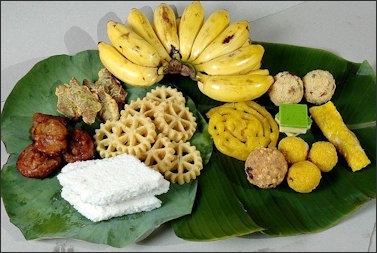
Tamil New Year foods
The Huffington Post reported; “ The study included 73,308 Seventh-Day Adventist men and women, who were recruited sometime between 2002 and 2007, and were followed for a mean time of 5.79 years. Over that time period, 2,570 people died. Researchers found that compared with nonvegetarians, all vegetarians had a 12 percent lower risk of dying over this time period. Specifically, vegans had a 15 percent lower risk of death, lacto-ovo-vegetarians had a 9 percent lower risk of death, pesco-vegetarians had a 19 percent lower risk of death and semi-vegetarians had an 8 percent lower risk of death. However, it’s important to note that people who are vegetarians tended to be more likely to be married, have higher education levels and be older and thinner. They were also more likely to exercise, to not smoke and to not drink. Researchers noted that all of these are also factors could play a role in their lower risk of death. =|=
Loma Linda University researchers have long been known for their studies on vegetarianism and health. In 2012, they presented findings showing that Seventh Day Adventist men who are vegetarians live 9.5 years longer, and Seventh Day Adventist women who are vegetarians live 6.1 years longer, than other people in California, Everyday Health reported. A study by University of Oxford researchers released in early 2013 showed that consuming a vegetarian diet lowers heart disease risk by 32 percent, compared with meat- and fish-eaters. That study included 45,000 people in the U.K.; 34 percent of them were vegetarians. Researchers found in that study that vegetarians were also less likely to have high body mass indexes, and also less likely to have diabetes. A 2011 study in the journal Diabetes Care showed that a vegetarian diet is linked with fewer metabolic risk factors, and a decreased risk of metabolic syndrome (considered a risk factor for Type 2 diabetes). =|=
Mumbai’s Vegetarian Enclave Shows Little Tolerance for Meat Eaters
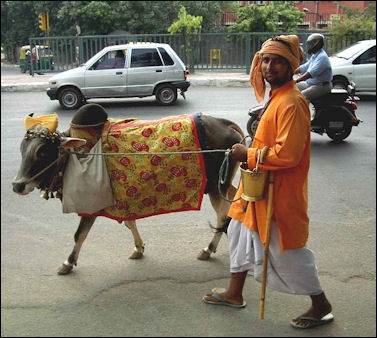 Shashank Bengali wrote in the Los Angeles Times, “In a roughly 2-square-mile patch containing some of India’s priciest real estate, a firm and sometimes militant vegetarianism prevails. Most residents of this old-money section of South Mumbai are Jains or devout Hindus, and not only do they not eat flesh, but they also don’t want it anywhere near them. Eateries serving meat and seafood are all but banned, and stories abound of certain apartment buildings refusing to consider prospective residents who are what Indians call ; sometimes with more than a soupcon of judgment ; non-vegetarians. [Source: Shashank Bengali, Los Angeles Times, November 24, 2014 */]
Shashank Bengali wrote in the Los Angeles Times, “In a roughly 2-square-mile patch containing some of India’s priciest real estate, a firm and sometimes militant vegetarianism prevails. Most residents of this old-money section of South Mumbai are Jains or devout Hindus, and not only do they not eat flesh, but they also don’t want it anywhere near them. Eateries serving meat and seafood are all but banned, and stories abound of certain apartment buildings refusing to consider prospective residents who are what Indians call ; sometimes with more than a soupcon of judgment ; non-vegetarians. [Source: Shashank Bengali, Los Angeles Times, November 24, 2014 */]
“They’re pretty fascist about it, says food writer Roshni Bajaj Sanghvi. I’ve seen Bengali friends and others complain that they’ve tried to move somewhere and the building says, ‘Oh, you are fish-eaters, you’ll smell up the place, so we won’t give you the apartment. A menu by prominent restaurateur Sanjay Narang that included tandoori chicken and lamb curry ticked off neighbors in an apartment building on an exclusive boulevard fronting the Arabian Sea. Narang shuttered his ground-floor establishment in 2005 after residents above reportedly spat on his patrons, dropped nails on them or keyed their cars. “ Starbucks’ “outpost off palm-fringed Marine Drive doesn’t sell the local-style club sandwiches or murg kathi wraps ; flatbreads stuffed with spiced chicken; found at dozens of other Starbucks in India. The brightly lighted display case contains only meatless fare: a hummus and pita platter, a spicy red bean sandwich, a mushroom and sun-dried tomato filling on ciabatta.*/
“There are no potatoes, onions or omelets in sight, either, in deference to Jains, who eschew not only meat but also eggs and root vegetables plucked from beneath the earth. Muffins, cakes and pastries made with egg are clearly labeled, in keeping with Indian law. Snack shops and ice cream stalls in the neighborhood bill themselves as 100% pure veg, including doughnuts that come in eggless varieties. If you open a non-veg restaurant there, said Sanghvi, even if they don’t force you to shut down, you will shut down eventually because the richest people in the neighborhood are vegetarian and your business doesn’t survive. */
“The penchant seems to run strongest in South Mumbai near Marine Drive, a sea-hugging thoroughfare... Patrons line up outside Veg and Proud restaurants that promise Jain Food Available. Many of the gently decaying old apartment blocks are occupied almost exclusively by Jains or well-connected merchant families from the neighboring state of Gujarat, who are strict vegetarians. (Prime Minister Narendra Modi, a Gujarati, served visiting heads of state an all-vegetarian menu at his inauguration in May.) The influx of these groups has not sat well with some native Marathis. */
“The Starbucks sits near a series of Gujarati-owned diamond boutiques and sweet shops and next to the Shree Krishna Hindu Merchants Club, a members-only establishment named for a Hindu god. The club naturally forbids meat (although it was long known for hosting underground high-stakes card games). To the west lies Malabar Hill, the city’s toniest district and site of a famous Jain temple, where many grocers don’t stock eggs and the handful of stalls that sell frozen meat and fish have faced occasional pressure to close. Basant Todi, whose family runs Kurries and Burries, a fast-food place across from Starbucks, said: Ninety percent of the people in this lane are Jains. If you have non-veg items, they will avoid you. */
“His tiny, colorful eatery features a typically eclectic Mumbai menu, including nachos and tom yum soup. But whereas its first location, in a suburban office park, serves Thai curries and khao suey, a Burmese noodle dish, here it has excised those dishes because they require onion and garlic. You can’t make a Jain khao suey, Todi explained. There are rare exceptions to the meat-free zone. An outpost of Domino’s Pizza, which once took chicken toppings off its menu, is currently non-vegetarian. And then there’s the venerable Kobe Sizzlers, which has been serving chicken, lamb and seafood stir-fries out of a buzzing ground-floor location for 35 years. Owner Urmila Sheth, a Gujarati grande dame wearing pearls and a giant diamond-studded nose ring, said hers was one of the first stir-fry restaurants to open in Mumbai. As the neighborhood has become more gastronomically conservative, her meat-heavy menu appears to have been grandfathered in. Yet even Sheth has recently converted to vegetarianism after deciding she couldn’t stomach the idea of a chicken being slaughtered. Her son, who helps manage the business, eats everything, she sighed, but Sheth no longer dines at her own restaurant. I can’t stand anyone eating fish at my table, she said.” */
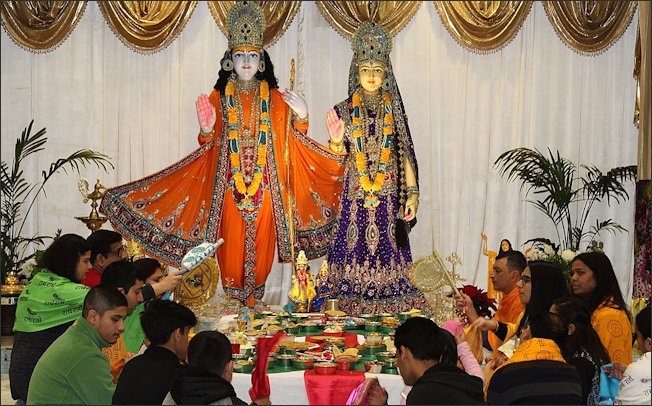
devotional offering of food to the deities Sita and Rama
Image Sources: Wikimedia Commons
Text Sources: “World Religions” edited by Geoffrey Parrinder (Facts on File Publications, New York); “Encyclopedia of the World’s Religions” edited by R.C. Zaehner (Barnes & Noble Books, 1959); “Encyclopedia of the World Cultures: Volume 3 South Asia “ edited by David Levinson (G.K. Hall & Company, New York, 1994); “The Creators” by Daniel Boorstin; “A Guide to Angkor: an Introduction to the Temples” by Dawn Rooney (Asia Book) for Information on temples and architecture. National Geographic, the New York Times, Washington Post, Los Angeles Times, Smithsonian magazine, Times of London, The New Yorker, Time, Newsweek, Reuters, AP, AFP, Lonely Planet Guides, Compton’s Encyclopedia and various books and other publications.
Last updated December 2023
